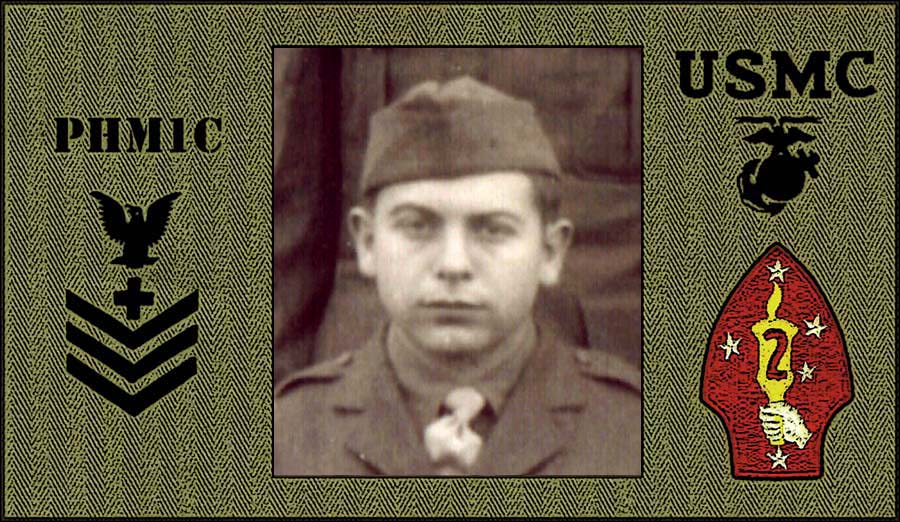 |
PhM2c
Paul E. SCHAFF
HEADQUARTERS COMPANY
1ST BATTALION 6TH MARINE REGIMENT
2ND MARINE DIVISION
FMF
 |
PhM2c
Paul E. SCHAFF
HEADQUARTERS COMPANY
1ST BATTALION 6TH MARINE REGIMENT
2ND MARINE DIVISION
FMF
Dr. Paul E. SCHAFF M.D.
On 21 NOV 1943 Dr. Schaff was a PhM2c (Corpsman), assigned to HQ Company, 1st Battalion, 6th Marine Regiment, 2nd Marine Division. Although he had just graduated with a B.S. Degree in Pharmacy, he had joined the USN as an enlisted man.
Beginning in 1946, Dr. Schaff went to medical school, completed his internship and went into general practice for two and a half years. He then went back to school and specialized in anesthesiology, which he continued to practice until he retired
He was 82 years old when I first spoke to him on November 6, 2003. We exchanged many emails and had additional telephone conversations for years afterward.
NOTES FROM MY CONVERSATIONS WITH DR. SCHAFF ON NOVEMBER 6, 2003
The 1/6 had a Headquarters Company and an A, B, C and D Company. He was in HQ Company, but some corpsmen were assigned directly to the other companies, usually about two corpsmen per company. He landed on Green Beach with the fourth wave of men leaving the USS Feland on 21 NOV 1943.
He said they climbed down rope ladders from the USS Feland into Higgins Boats. The Higgins Boats then took them part of the way to Green Beach and dropped them off about 1000 yards off shore. They then transferred into their rubber boats and began paddling to shore. There were about eight to ten men to each rubber boat, usually four of them at each side paddling with their outboard legs in the water. They did have some radio information that advised them to land between the two large fires on the beach, but since there were at least three large fires on the beach this information wasn’t particularly helpful.
He was near the rubber boat that PhM2c Hildebrand was in when it began going flat. PhM2c Hildebrand and the other occupants were picked up by one of the two LVT-1s that were accompanying the rubber boats. The men in the remaining rubber boats were shouting at them and complaining about how lucky they were to get a free ride in while everyone else had to paddle.
The LVT-1 continued toward Green Beach and when it was about 200 yards ahead of them it struck a mine.The explosion tore it apart and turned it upside down in the water.
He heard someone callout: “Dr. Deffinger, Help me!” They went to the wreck and found Phm3c Hoatson who had suffered a “broken femur." Other marines had arrived there within 1 to 2 minutes after the explosion and helped Hoatson. They could find no signs or sounds of life in or around the LVT. They tried for quite a while.
They put Hoatson in a large splint and loaded him onto the second LVT to be taken to the beach.
It was almost dark when his rubber boat landed near the large coastal gun at the south end of Green Beach. He teamed up with two other corpsmen who had seen combat at Guadalcanal. They were PhM2c Jirah D. Russell (his best friend) and PhM2c Jack G. Stoltenberg. They insisted on finding good cover for the night. They went down into a large shell-hole near where the LVT (with Hoatson) had parked. He said there were two dead Japanese soldiers in the shell-hole with them. The other two corpsmen told him not to touch them because they might be “booby-trapped.” He said that the warning was unnecessary, since he really had no intention of touching them.
He said Hoatson was left in the LVT for the night, because they thought it would be safer for him. He said that it was bright moonlight when the Japanese bomber flew over later that night and he was able to see it clearly. It was a twin-engine bomber known as a “Betty” by the allies. The many fires burning on the island also enhanced his ability to see the bomber. The bomber dropped several bombs near the LVT. He said that Hoatson was blown out of the LVT by one of the bombs, but did not suffer any additional injuries. Hoatson landed in the sand nearby and he and the other two Corpsman pulled him into the shell hole with them.
Note: PhM3c Hoatson had survived the mine-blast in the first LVT only to be blown out of the second LVT by an aerial bomb. On the following day they loaded Hoatson into yet another LVT to be taken out (through the same mine field) to a Hospital ship. He said that Hoatson was a little apprehensive. "Terrified" was a word he also used.
(Click here to read Sgt. Smiley's account of the same event.)
___________________________________________________________________________________________________
PLEASE CONTACT ME IF YOU HAVE ANY ADDITIONAL INFORMATION